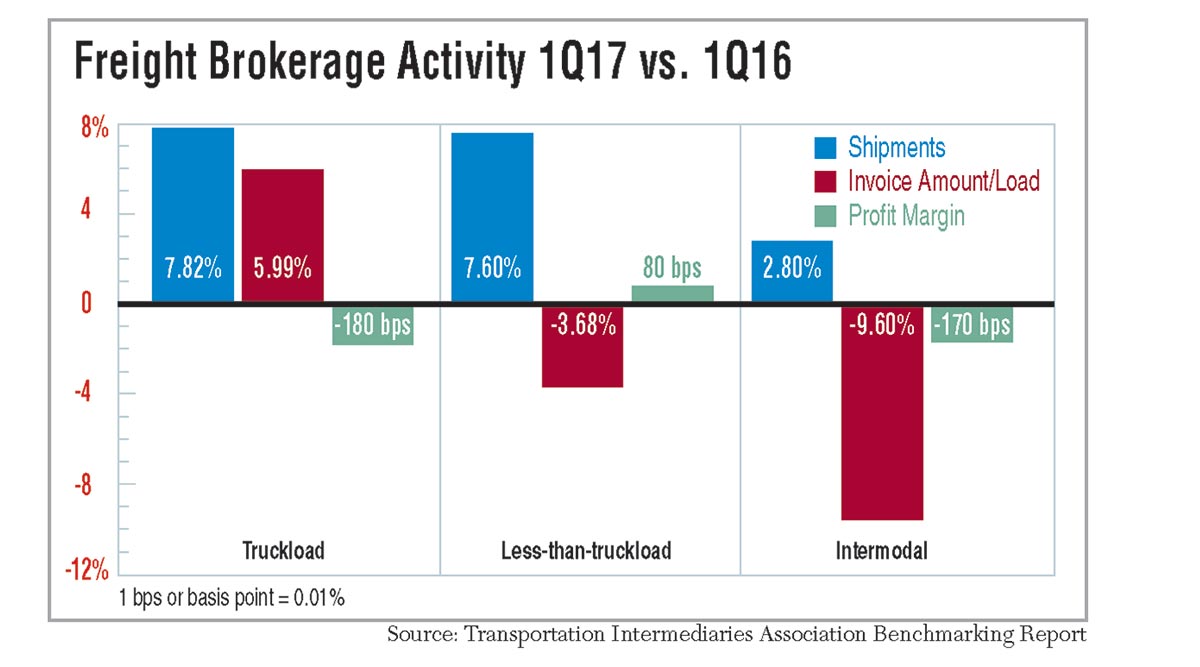1Q Shipments Up, Margins Shrink; Contract Rates Weaken, TIA Says

This story appears in the May 29 print edition of Transport Topics.
Freight brokers reported that shipments and revenue increased in the first quarter compared with a year ago, but margins declined due to a tight pricing environment, according to the Transportation Intermediaries Association.
Like motor carriers, freight brokers faced pricing pressure from shippers resolved to slash rates or hold the line on annual contracts before digging into their pockets in 2018. As a result, margins were compressed in the quarter, based on interviews with third-party logistics executives.
Total shipments rose 7.5% to 1.29 million year-over-year and revenue grew 12% to $2.24 billion, but profit margins declined 120 basis points after purchased transportation costs to 15%.
Volumes in truckload increased 7.8% year-over-year to 877,406, less-than-truckload rose 7.6% to 123,679 and intermodal improved 2.8% to 253,218.
But average truckload profit margins deteriorated 180 basis points to 15.1%, and intermodal margins fell 170 points to 8.7%. Less-than-truckload margins, however, improved 80 basis points to 19.6%.
“It was a difficult contract bid season [in truckload], and when you don’t get the rates, compression tends to occur,” said Mark Christos, author of the report and vice president at Matson Logistics.
Kevin Nolan, founder and CEO of Nolan Transportation Group, added that margins were stable in January in February but deteriorated heavily beginning in March.
“Everyone I know was operating at nearly 200 basis points less than they’re used to, and we definitely saw it on our end,” Nolan said. “Freight wasn’t sitting on their docks because there was capacity, so shippers went into the bid cycle saying, ‘I don’t understand why there would be a price increase because my freight is still getting moved.’ And it’s so competitive out there that I think some are willing to work at a little bit of a lower margin,” he said.
Nolan Transportation ranks No. 26 on the Transport Topics sector list of the top freight brokerage firms in North America.
Kenny Lund, vice president of operations at Allen Lund Co., agreed that margins slipped 200 basis points or more in the first quarter. He also said they deteriorated further during the second quarter to 400 basis points in April and May — a sentiment other 3PL executives echoed. Allen Lund Co. ranks No. 20 on the brokerage sector list.
“It seemed like, if you tried to raise rates, you lost lanes. It was very competitive among brokers,” Lund said. “Everywhere else, if you want to lock in a 12-month price, it costs you more money. In our industry, we lock in the same rate for the year and then bet as to what the market will actually do.”
Nevertheless, Lund doesn’t worry because the first half of 2016 was better than the second, so the year-over-year comparisons are tougher to match. Plus, if the economy rebounds, he said, capacity will tighten quickly in addition to any effect from the electronic logging mandate.
Scott Logistics Corp., No. 44 among the freight brokerages, told Transport Topics that load counts and revenue grew 13% year-over-year in the first quarter but that the truckload profit margins were similar to the TIA report.
“The demand for carrier capacity is as tight as we have seen it in a long time, resulting in higher cost to secure trucks for our loads. Likewise, the rates from customers certainly hasn’t increased at the same level, which is creating the margin compression that is being experienced in the industry,” Scott Logistics President Jay Matthews said. “I am not confident that this will be a short-term situation, but we are doing our best to mitigate it.”
Less-than-truckload was the sole bright spot in terms of profit margins, even though the mode represented only 9% of the business activity in the survey. Truckload was 68% and intermodal was 20%.
Dan Evans, president of Cowan Logistics, described business as “healthy and growing” in LTL, “stable” in intermodal and “uncertain” in truckload — using the word “flat” on overall conditions. He attributed the results to the shift from brick-and-mortar to e-commerce boosting LTL last-mile delivery.
“There is an 800-pound gorilla called Amazon. We used to talk about the Wal-Mart or the Southwest effect. Now we’re all seeing the Amazon effect in the world of transportation,” Evans said, referring to retailer Amazon.com. “The final-mile parcel, small freight, LTL business is growing, and that freight ultimately has to come from some place if the overall economy isn’t robust. It’s coming out of the brick-and-mortar world where the truckload guys live and breathe,” Evans said.
Revenue and margins were up single digits in the first quarter at Baltimore-based Cowan Logistics, which ranks No. 47 on the Transport Topics Top 50 list of the largest logistics companies in North America. Evans attributed the results to the strong relationships with shippers and carriers.
“Major shippers have done a good job of squeezing on price and locking in the lowest price imaginable. At Cowan Logistics, we are focused on shippers that are very service-oriented, where transportation is often considered to be less of a commodity,” he explained.




